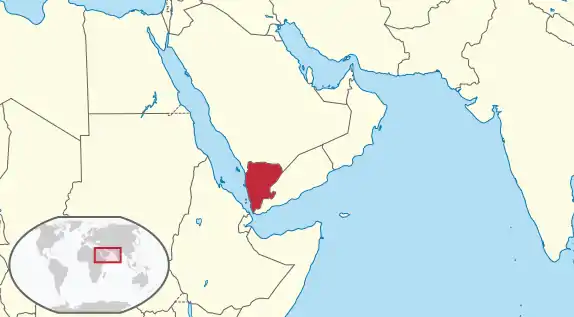North Yemen
North Yemen (Arabic: اليمن الشمالي al-Ālšmāly al-Yamanīyah), was a sovereign state that existed in the Arabian peninsula from 1918 until 1990 in the northern part of what is now Yemen. Its capital was Sana'a from 1918 to 1948 then again from 1962 to 1990. In 1962, the country fought a bloody civil war until the monarchist defeat in 1970. North Yemen was admitted to the United Nations on 30 September 1947 and was one of the predecessor states of Yemen, alongside South Yemen, until its eventual unification.
North Yemen | |||||||||
|---|---|---|---|---|---|---|---|---|---|
| 1918–1990 | |||||||||
  | |||||||||
Anthems: السلام الوطني (English: Royal Salute) (1918-1962) Peace To The Land (1962-1978) A Nation's Will (1978-1990) | |||||||||
 Location of North Yemen on the Arabian Peninsula after shrinking in 1934. | |||||||||
| Status | Member of the United Nations (1947-present) | ||||||||
| Capital | Sana'a (1918–1948, 1962–1990) Ta'izz (1948–1962) | ||||||||
| Common languages | Arabic | ||||||||
| Religion | Zaidi and Sunni Islam | ||||||||
| Government | Mutawakkilite Kingdom of Yemen (1918-1990) Yemen Arab Republic (1970-1990) Details
| ||||||||
| Historical era | 20th century | ||||||||
• Independence from the Ottoman Empire | 30 October 1918 | ||||||||
| 30 September 1947 | |||||||||
| 1 December 1970 | |||||||||
| 22 May 1990 | |||||||||
| Area | |||||||||
| 1990 | 195,000 km2 (75,000 sq mi) | ||||||||
| Population | |||||||||
• 1990 | 7,160,981 | ||||||||
| Currency | North Yemeni rial | ||||||||
| Time zone | UTC+3 | ||||||||
| Calling code | 967 | ||||||||
| |||||||||
| Today part of | |||||||||
History
Following the collapse of the Ottoman Empire in 1918 after the Great War, northern Yemen became an independent state as the Mutawakkilite Kingdom of Yemen. On 27 September 1962, revolutionaries inspired by the Arab nationalist ideology of United Arab Republic (Egyptian) President Gamal Abdel Nasser deposed the newly crowned King Muhammad al-Badr, took control of Sanaʽa, and established the Yemen Arab Republic (YAR). This coup d'état marked the beginning of the North Yemen Civil War that pitted YAR troops, assisted by the United Arab Republic (Egypt), against Badr's royalist forces, supported by Saudi Arabia and Jordan. Conflict continued periodically until 1967, when Egyptian troops were withdrawn to join the conflict of the Six-Day War. By 1968, following a final royalist siege of Sanaʽa, most of the opposing leaders reached a reconciliation. Saudi Arabia recognized the Republic in 1970.
Unlike East and West Germany or North and South Korea, the YAR and its southern neighbor, the People's Democratic Republic of Yemen (PDRY), also known as South Yemen, remained relatively cordial, though relations were often strained. Following the Yemenite War of 1972, the two nations declared that unification would eventually occur. However, these plans were put on hold due to the Yemenite War of 1979, and war was stopped only by an Arab League intervention. The goal of unity was reaffirmed by the northern and southern heads of state during a summit meeting in Kuwait in March 1979.
Unification
In May 1988, the YAR and PDRY governments came to an understanding that considerably reduced tensions. They agreed to renew discussions concerning unification, to establish a joint oil exploration area along their undefined border, to demilitarize the border, and to allow Yemenis unrestricted border passage on the basis of a national identification card.
Official Yemeni unification took place on May 22, 1990, with a planned, 30-month process, scheduled for completion in November 1992. The first stamp bearing the inscription "Yemen Republic" was issued in October 1990.[1] While government ministries proceeded to merge, both currencies remained valid until 11 June 1996. A civil war in 1994 delayed the completion of the final merger.
See also
- History of Yemen
- Imams of Yemen
- Yemen Arab Republic
- United Nations Security Council Resolution 188
- Yemen
- The coat of arms on the right was used by the Yemen Arab Republic (1970-1990); the version on the right was used by the Kingdom of Yemen (1918-1970).
References
- Scott (2008) "Yemen," Scott 2009 Standard Postage Stamp Catalogue Volume 6 (165th edition) Scott Publishing Co., Sidney, Ohio, page 1081. ISBN 978-0-89487-422-2
.svg.png.webp)
.svg.png.webp)
